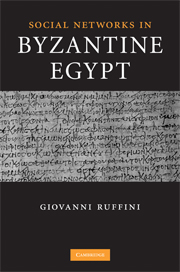Book contents
- Frontmatter
- Contents
- Dedication
- List of figures
- List of tables
- Acknowledgements
- References and abbreviations
- Introduction
- Chapter 1 The centralized elite of Oxyrhynchos
- Chapter 2 The growth of the Apions
- Chapter 3 Aphrodito and the strong ties of village society
- Chapter 4 Quantifying Aphrodito's social network
- Conclusion
- Stemmata
- Bibliography
- Subject index
- Index locorum
Chapter 2 - The growth of the Apions
Published online by Cambridge University Press: 26 June 2009
- Frontmatter
- Contents
- Dedication
- List of figures
- List of tables
- Acknowledgements
- References and abbreviations
- Introduction
- Chapter 1 The centralized elite of Oxyrhynchos
- Chapter 2 The growth of the Apions
- Chapter 3 Aphrodito and the strong ties of village society
- Chapter 4 Quantifying Aphrodito's social network
- Conclusion
- Stemmata
- Bibliography
- Subject index
- Index locorum
Summary
INTRODUCTION
The Apions were the largest and most influential of the great Oxyrhynchite families. The growth and spread of their estate through the Oxyrhynchite nome transformed the region's social geography. Their estate's economic activities – both land ownership and fiscal responsibility – connected them to a considerable percentage of the nome's population. I argue below that the Apionic bureaucracy had ties to roughly 15 per cent of the nome's population, over 10,000 people, at a conservative estimate. How the family gained this level of prominence has never been satisfactorily explained, but the analyses in this chapter provide helpful clues.
Network analysis of Apionic toponyms indicates that the Apionic estates did not grow outward from a rural, ancestral core with a specific regional focus. Rather, Apionic places appear everywhere in the Oxyrhynchite topographical network, linked as much to each other as to other places beyond Apionic reach. Moreover, network measurements of centrality show that the Apions were most important in locations that were in some cases relatively obscure. These conclusions, taken in combination, enhance the picture presented in Chapter 1, that the social and economic ties of the Oxyrhynchite elite created considerable hierarchical centralization throughout the nome, a centralization driven from the city itself.
Because the Apionic oikos is the best-documented institution in late antique Oxyrhynchos, if not in all of late antique Egypt, it represents a singular opportunity for exploring the region's social connectivity.
- Type
- Chapter
- Information
- Social Networks in Byzantine Egypt , pp. 94 - 146Publisher: Cambridge University PressPrint publication year: 2008



